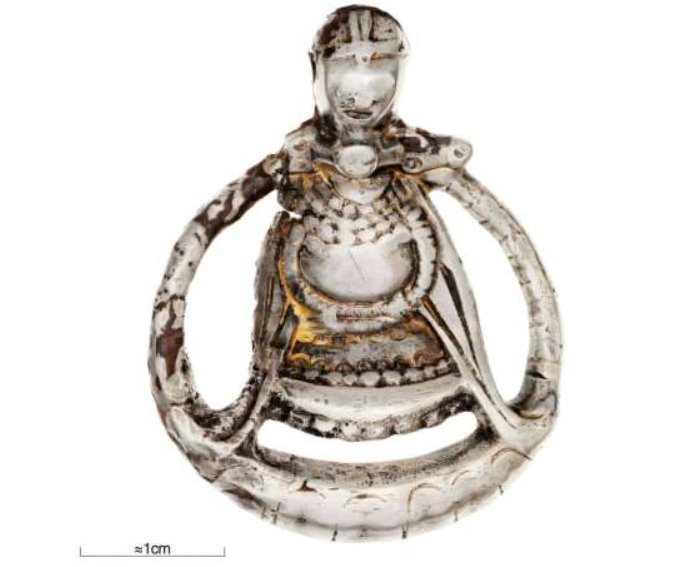Conny Waters – AncientPages.com – Scholars specializing in Viking studies from the Universities of Nottingham and Leicester have conducted an examination of pregnancy during the Viking Age. Their research – the first focused examination of pregnancy in the Viking Age – reveals that pregnant women were often portrayed in art and literature adorned with martial gear.
Additionally, it was found that newborns entered a challenging environment where not all received burial rites or were born into freedom.
Pendant showing the only known Viking-Age depiction of a pregnant body. The artefact was found in a 10th century, Swedish burial for a woman, buried with a rich and varied artefacts assemblage as well as animals — one interpretations is that she was a ‘seeress’/ritual specialist. (Credit: O. Myrin, The Swedish History Museum/SHM)
The research, published in the Cambridge Archaeological Journal and supported by funding from the European Research Council (ERC), utilizes multidisciplinary evidence to explore linguistic and narrative representations of pregnancy in later Old Norse sources. It includes an analysis of a unique Viking Age figurine that convincingly portrays a pregnant figure adorned with a martial helmet, as well as burial evidence suggesting potential victims of obstetric deaths.
“Using Old Norse texts to illuminate Viking Age beliefs is difficult because the surviving manuscripts date to well after the Viking Age, but it is still fascinating to see words, concepts and memories of pregnancy in these sources that may have their roots in the earlier Viking period,” said Dr Katherine Olley, Assistant Professor in Viking Studies and Director of the Centre for the Study of the Viking Age, who examined Old Norse words, stories and legal regulations surrounding pregnancy.
“Among the Norse words used for denoting pregnancy, we find rich terms such as ‘bellyfull,’ ‘unlight,’ and ‘to walk not a woman alone’ which provide glimpses of ways people may have conceptualised pregnancy.”
In one saga studied by Dr. Olley, a fetus is destined to avenge his father, entangled before birth in kinship, feuds, and violence. Another saga features Freydís, who during a violent encounter can’t flee due to her late-term pregnancy. Undaunted, she picks up a sword, bares her breast, and strikes it against her chest to scare away the assailants.
The expert in Viking Studies remarks: “Freydís’s actions are unexpected, yet they may find a parallel in the study’s analysis of a silver figurine depicting a pregnant woman, her arms encircling her prominent belly, adorned with what seems to be a helmet featuring a noseguard. While we exercise caution in avoiding oversimplified narratives regarding pregnant warrior women, it is essential to recognize that both art and literature of the time circulated notions of pregnant women equipped for battle. These representations do not portray passive or subdued pregnant figures.”
The study contributes to research on gender, bodies, and sexuality in the Viking Age and to the broader discussion of how scholarship addresses traditional women’s issues in the ‘natural’ or ‘private’ sphere.
“It verges on the banal to say, but pregnancy is an absolute necessity for all forms of reproduction – demographic, social, economic, political. Without pregnant bodies, none of us would be here. Questions such as whether a pregnant body is one or two, how kinship works, or when personhood begins, are not devoid of politics and we don’t have to look very far into our contemporary world to recognise that,” Dr Marianne Hem Eriksen, Associate Professor of Archaeology at the University of Leicester said.
It is noteworthy that references to pregnancy are absent in the evidence from the Viking Age. The authors observe that, among the thousands of burials documented throughout the Viking World, there exist only a limited number of potential mother-infant interments from this era. This observation is particularly significant given that obstetric mortality rates are believed to have been exceedingly high during this period.
Research suggests mothers and babies are not often buried together, with infants under-represented in Viking Age burials overall. Some appear in domestic houses, but their burial practices remain unclear compared to adults.
“Together with legal legislation such as pregnancy being seen as a ‘defect’ in an enslaved woman to be bought, or children born to subordinate peoples being the property of their owners, it is a stark reminder that pregnancy can also leave bodies open for volatility, risk and exploitation,” adds Dr Eriksen.
Written by Conny Waters – AncientPages.com Staff Writer


